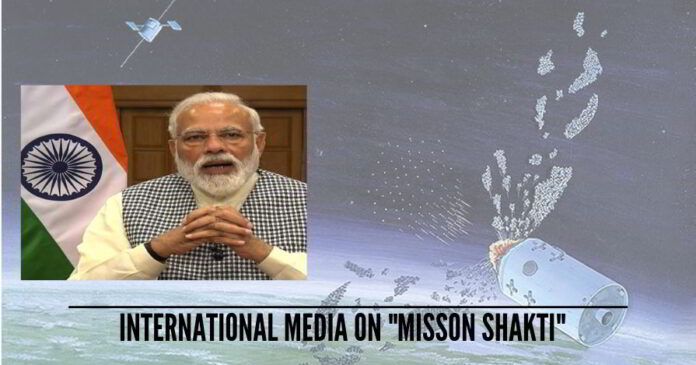
On Wednesday, March 27th 2019, India “registered its name as a space power” by shooting down a live satellite in space.
Below are coverage’s from various international media on “Mission Shakti”.
Mirror – UK [1]
The anti-satellite device can blind enemies, disrupt communications and providing a technology base for intercepting ballistic missiles.
Speaking on live television, Mr Modi said: “Some time ago, our scientists, shot down a live satellite 300 kilometres (186 miles) away in space, in low-earth orbit. India has made an unprecedented achievement today. India registered its name as a space power.
The missile showed remarkable precision and technical capacity, the politician, who faces a general election in April, added.
Mr Modi, 68, added: “This is a big moment for India. Something that all of us should be proud of. We are not just capable to defend on land, water and air, but now also in space.”
India was already a space power before this test, claims Jessica West, a program officer at Project Ploughshares and the managing editor of its Space Security Index.
The Wall Street Journal – USA [2]
With the Wednesday morning test—which destroyed an Indian satellite orbiting around 186 miles up—the South Asian nation became the fourth to prove capable of targeting the thousands of satellites circling the Earth, crucial links for communication, military and intelligence networks. The others are the U.S., Russia and China.
DW – Germany [3]
Although Modi said the test exercise, deemed “Mission Shakti” (Hindi for “power”), was not aimed at any one country, the announcement could inflame tensions with Pakistan just days ahead of a crucial election.
Indian space expert Ajay Lele underscored Modi’s claim by saying: “India is not placing weapons in space. A ground-based missile defence interceptor system was used to destroy the satellite. If some country or adversary places a satellite for intelligence or for troubling India, India now has the capability to remove such an irritant.”
Modi praised the effort on Twitter, saying it was important because it was an entirely indigenous effort. India has an ambitious space program, having launched probes to the moon and Mars, as well as unveiling plans for a manned space mission by 2022.
ARAB News [4]
Named “Mission Shakti,” the test of the indigenously built ASAT missile was carried out by the Defense Research Development Organization (DRDO).
In a statement released after Modi’s address, the External Affairs Ministry said: “India has tested and successfully demonstrated its capability to interdict and intercept a satellite in outer space based on complete indigenous technology.”
The ministry said: “At the same time, the government is committed to ensuring the country’s national security interests, and is alert to threats from emerging technologies. The capability achieved through the anti-satellite missile test provides credible deterrence against threats to our growing space-based assets from long-range missiles and proliferation in the types and numbers of missiles.”
China’s Foreign Ministry said it “hopes that each country will uphold peace and tranquillity in outer space.”
India’s opposition termed Modi’s address to the nation as theatrics and an attempt to divert attention away from real issues in the middle of an election campaign.
GIZMODO – Hungary [5].
Modi’s critics claim the prime minister is deliberately (and possibly illegally) trying to swing votes. Also, the test occurred as the Group of Governmental Experts (GGE) met in Geneva to discuss the prevention of an arms race in outer space (PAROS); India’s actions can be construed as a kind of slap in the face.
India was already a space power before this test, claims Jessica West, a program officer at Project Ploughshares and the managing editor of its Space Security Index. She finds it concerning that the nation needed a weapons test to further consolidate this standing.
“There are other ways that this capability could have been demonstrated, that would have caused less harm and been less aggressive, such as a flyby test,” West told Gizmodo. “There is nothing defensive about an ASAT test. They are inherently offensive. And such destructive capability does little to enhance national security in outer space. Instead, we need to be focusing on enhancing common security within this global—and highly sensitive—domain.”
This technological leap, which was confirmed by the Pentagon, puts India in an exclusive club of nations, along with the United States, Russia and China, that have proved their ability to destroy targets in space
Stuff – New Zealand [6]
The announcement is Modi’s latest bid to flex India’s military muscle as his party seeks to retain power in polls beginning April 11.
Global News – Canada [7]
Pallava Bagla, a science writer at the New Delhi Television Channel, said that by successfully hitting the fast-moving satellite, India had crossed a “very significant threshold.”
“India demonstrated that we can, if threatened, bring down an enemy satellite in space,” Bagla said.
The Telegraph – UK [8]
Official sources told the Telegraph the missile was a “kinetic kill vehicle” that did not carry any explosives or other devices.
They said its “kill” capability arose simply from the fact that it smashed into the target satellite at high speed.
In an official statement India’s foreign ministry declared that the debris generated from the impact would “decay and fall back to earth within weeks” as the test was executed in the “lower atmosphere”.
The foreign office also stressed that the test was not directed against any country, but added that the capability provided India “credible deterrence against threats to its space-based assets from enemy missiles”.
This was a thinly veiled reference to Pakistan and China that similarly destroyed a weather satellite in 2007, creating the largest orbital debris in history.
The Sun – UK [9].
The feat makes India just the fourth country to possess ASAT tech, after the United States, China and Russia.
India’s version is comprised of a three stage missile that fires into space from a mobile missile launcher truck.
Once in the air, it is guided to its target by a long-range radar system on the ground, which is also identifies the target and tracks it through space.
Travelling faster than a mile per second, the weapon hones in on the satellite before destroying it with an almighty blast.
DAWN- Pakistan [10]
The Foreign Office spokesperson, Dr Mohammad Faisal in his statement on Wednesday, stated Pakistan’s position on the matter, saying: “Pakistan has been a strong proponent of the prevention of arms race in outer space.”
Furthermore, in his statement, the spokesperson expressed hope that “countries which have in the past strongly condemned demonstration of similar capabilities by others will be prepared to work towards developing international instruments to prevent military threats relating to outer space”.
Independent – UK [11]
The target of the test was “one of India’s existing satellites operating in lower orbit”, a foreign ministry source said, rather than an asset belonging to another country. Experts said a mini-satellite was put into low orbit one month ago, likely for this purpose.
The Jakarta Post – Indonesia [12]
“This is significant. India can now take out Chinese communication systems, for instance,” said Bharat Karnad, Delhi-based security expert at the Centre for Policy Research. “The PM is going to derive whatever political benefits he can in the election season — why would he give up the chance?”
India’s space and missile programs — along with its economic growth of more than 7 percent and a bid for a permanent seat in the United Nations Security Council — is major part of the country’s efforts to build up its defense capabilities and establish itself as a world power.
The New York Times – USA [13]
This technological leap, which was confirmed by the Pentagon, puts India in an exclusive club of nations, along with the United States, Russia and China, that have proved their ability to destroy targets in space.
Space News – US [14]
According to a statement from India’s Ministry of External Affairs, the missile was launched from the Dr A P J Abdul Kalam Island launch complex in the northeast part of the country. The missile struck an unidentified Indian satellite. “The test was fully successful and achieved all parameters as per plans,” the ministry stated.
Neither Modi nor the ministry identified the satellite targeted by the test. Indian media speculated that the likely targets were either Microsat-R, launched in January or Microsat-TD, launched a year earlier. Microsat-R is in a 262-by-280-kilometre orbit, while Microsat-TD is in a 353-by-361-kilometre orbit, according to tracking data by the U.S. military.
The ministry said in its statement that the test was designed to minimize long-lived debris. “The test was done in the lower atmosphere to ensure that there is no space debris. Whatever debris that is generated will decay and fall back onto the earth within weeks.” It wasn’t immediately known how much debris the test generated, but some debris may end up in higher orbits with longer decay times.
References:
[1] India shoots down live space satellite in just THREE minutes – Mar 27, 2019, Mirror
[2] India Successfully Tests Satellite-Killer Missile – Mar 27, 2019, The Wall Street Journal
[3] India shoots down satellite, becomes ‘space superpower’ – Mar 27, 2019, DW
[4] Modi declares India a ‘space power’ after satellite shot down – Mar 27, 2019, Arab News
[5] India Declares Itself a ‘Space Power’ After Shooting Down Its Own Satellite – Mar 27, 2019, GIZMODO
[6] India says it successfully test-fires anti-satellite weapon – Mar 27, 2019, Stuff
[7] India says it shot down a fast-moving satellite, declares itself a ‘space power’ – Mar 27, 2019, Global News
[8] India becomes space ‘superpower’ after shooting down satellite – Mar 27, 2019, The Telegraph
[9] India now a ‘space power’ as PM Modi reveals successful missile attack on low-orbit satellite – Mar 27, 2019, The Sun
[10] India claims to shoot down satellite, join ‘space superpowers’ – Mar 27, 2019, DAWN
[11] Mission Shakti: India shoots down live satellite in space, says PM Narendra Modi – Mar 27, 2019, Independent
[12] Modi says satellite destruction shows India a `space power’ – Mar 27, 2019, The Jakarta Post
[13] India Shot Down a Satellite, Modi Says, Shifting Balance of Power in Asia – Mar 27, 2019, The New York Times
[14] India tests anti-satellite weapon – Mar 27, 2019, Space News
- Subramanian Swamy approaches Supreme Court on Govt’s modification of 2G Scam Judgment to avoid auction of Satellite Spectrum - April 23, 2024
- Defence Minister Rajnath Singh visits Siachen. Reviews military preparedness - April 22, 2024
- Amit Shah’s shares in the Stock Market almost doubled in the past five years - April 21, 2024










